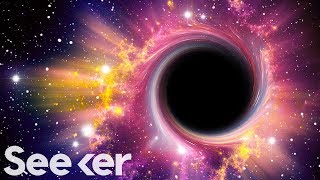We know there tend to be supermassive black holes at the center of galaxies, but the nuances of galactic evolution are still a mystery.
我们知道星系中心往往有超大质量黑洞,但银河系演化的细微差别仍然是个未解之谜。
Now two discoveries may shed light on these dark places and the galaxies that form around them.
现在,有两个发现可能为这些黑暗之地及其周边星系揭开谜团。
In a cloud of molecular gas near the center of the Milky Way -- so in our own neighbourhood -- astronomers have found a giant black hole 100,000 times the mass of the Sun.
在银河中心附近的一团分子气体云中——也是在我们自己邻居的附近——天文学家发现了一个巨大的黑洞,是太阳大小的100,000倍。
It's the second largest supermassive black hole in our galaxy and the best evidence of a class of 'intermediate-mass' black holes.
它是我们银河系中第二大的超级黑洞,也是“中间质量”黑洞存在的最好证据。
Astronomers have been looking for these because they might be the key to understanding how supermassive black holes can get so big.
天文学家一直在寻找它们,因为它们可能是理解超大质量黑洞为何变得如此之大的关键。
We know that supermassive black holes formed early in the Universe's lifetime, we just don't totally know how.
我们知道在宇宙生命早期,超大质量黑洞就已经形成,我们只是并不完全知道。

But one theory says that intermediate-mass black holes might act as seeds for their supermassive cousins.
但是有一种理论认为中间质量黑洞可能是它们超大质量黑洞表亲的种子。
Larger, more gravitationally-dominant galaxies could cannibalize smaller ones that cross their paths, the larger black hole at the center pulling the material of the smaller one into itself.
更大更加重力占优的星系能够吃掉穿越它们路径的较小星系,位于中心的较大黑洞将较小物质拉入其自身体内。
That means, mid-sized black holes could have combined to form supermassive structures, right?
这意味着,中等大小的黑洞可能结合起来形成超大质量的结构,对吗?
The thing is, we also recently found the furthest supermassive black hole, which means it's super old.
问题是,我们最近发现了最大的超大质量黑洞,这意味着它超级老了。
With a mass 800 million times greater than our Sun, it's enormous.
它的质量比我们的太阳大8亿倍,非常巨大。
And did I mention, it's old?
我提到过吗?它很老了?
It grew far larger than expected in the 690 million years after the Big Bang... (which is the blink of an eye considering the Universe is more than 13 billion years old).
在大爆炸后的6.9亿年里,它比预期要大得多(这是眨眼之间的事,考虑到宇宙诞生已经超过130亿年了。)
This relic from the earliest days of the universe is also devouring all the material near it meaning it's a quasar, another indication it formed early in the Universe's life.
宇宙早期的遗迹也吞噬了它附近的所有物质,这意味着它是一个类星体,是宇宙生命早期形成的另一个迹象。
This black hole is proving to be a window into a transitional period for the Universe, but it's also throwing a bit of a wrench into how we understand black holes' formation.
这个黑洞被证明是一个进入宇宙过渡期的窗口,但它也妨碍了我们对黑洞形成的理解。
Nothing astronomers have measured can explain how a supermassive black hole got this big so long ago.
天文学家所测量的一切都无法解释一个超大质量黑洞在很久以前,是如何变得如此之大的。
Something had to have facilitated such rapid growth, they just don't know what that SOMETHING is yet.
一定有什么东西促使了如此迅速的增长,他们只是不知道那是什么东西。
It could be that intermediate black holes hold an answer.
可能是中间质量黑洞那里存在答案。
But for the moment that remains a theory.
但目前这仍然只是一个理论。
Astronomers will need more observations and more data to solidify any link between smaller black holes and the supermassive ones that dominate galaxies;
天文学家还需要更多观测和数据,来巩固稍小质量黑洞与超大质量黑洞之间的联系,而后者主宰着星系;
not to mention explain how massive black holes could form so early in the Universe's life.
更不用说解释宇宙生命早期如何形成了这么大的黑洞了。
Nevertheless, these discoveries are taking us one step closer to answering the big question of how galaxies evolve.
然而,这些发现使我们更接近于星系如何演化这个大问题的答案。
If you liked this video be sure to subscribe for more science in your daily life, and if you're curious about what else is happening in space, check our playlist here.
如果你喜欢这个视频,请订阅更多节目,而如果你好奇宇宙中还在发生什么的话,请查看我们的节目单。
The weirdest thing about black holes is that we, of course, can't see them.
关于黑洞最奇怪的事情当然是我们根本看不到他们。
Astronomers infer their existence from the material around them. So cool!
天文学家只是从周围的物质推断出它们的存在。太酷了!


